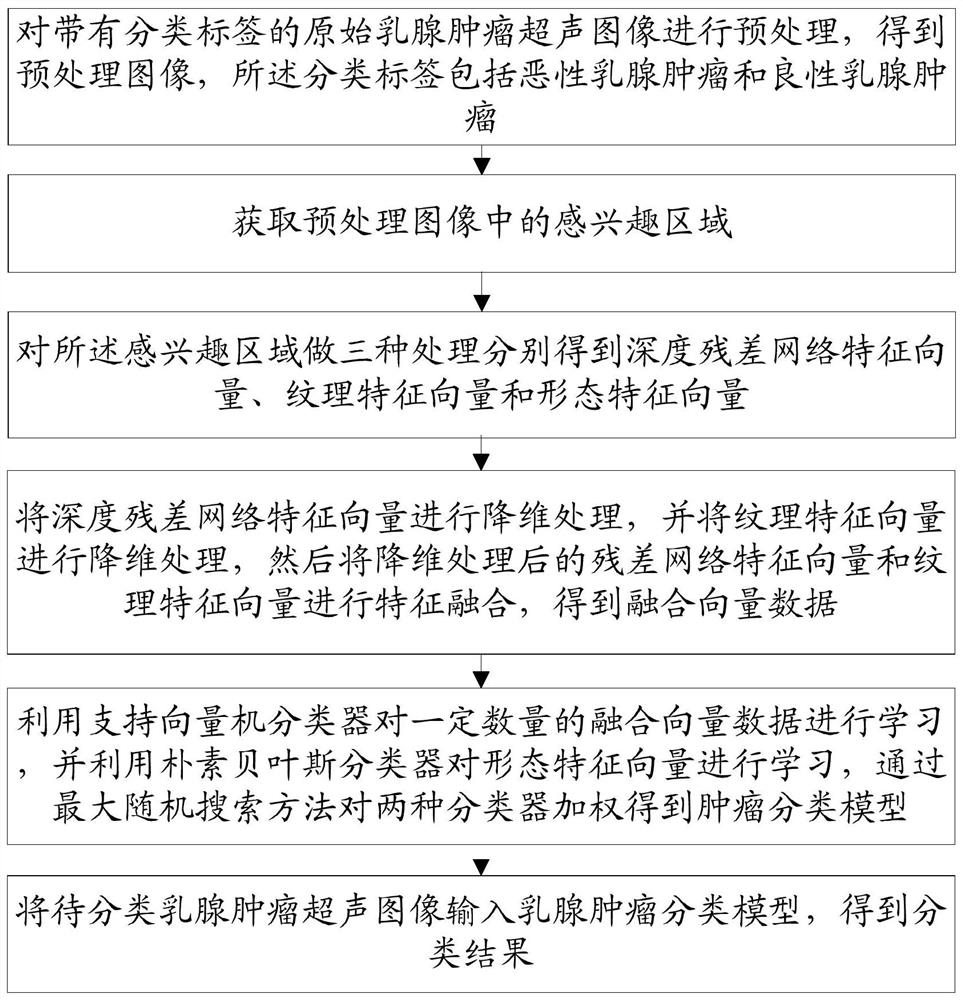Breast tumor benign and malignant classification method and device based on ultrasonic image and medium
A breast tumor and ultrasound image technology, applied in the field of medical image processing, can solve the problems of high gray level, inaccurate automatic classification of breast tumor ultrasound images, and difficulty in distinguishing gray-scale similar areas in ultrasound images.
- Summary
- Abstract
- Description
- Claims
- Application Information
AI Technical Summary
Problems solved by technology
Method used
Image
Examples
Embodiment 1
[0079] This embodiment provides a method for classifying benign and malignant breast tumors based on ultrasound images, such as figure 1 As shown, the method includes:
[0080] Step 10, preprocessing the original breast tumor ultrasound image with a classification label to obtain a preprocessed image, and the classification label includes malignant breast tumors and benign breast tumors;
[0081] Step 20, obtaining the region of interest in the preprocessed image;
[0082] Step 30, performing three types of processing on the region of interest to obtain the depth residual network feature vector, texture feature vector and morphological feature vector;
[0083] Step 40, performing dimensionality reduction processing on the deep residual network feature vector, and dimensionality reduction processing on the texture feature vector, and then performing feature fusion on the residual network feature vector and texture feature vector after dimensionality reduction processing, to ob...
Embodiment 2
[0130] This embodiment provides a device for classifying benign and malignant breast tumors based on ultrasound images, such as figure 2 As shown, the device includes:
[0131] The preprocessing module is used to preprocess the original breast tumor ultrasound image with a classification label to obtain a preprocessed image, and the classification label includes malignant breast tumors and benign breast tumors;
[0132] The ROI acquisition module is used to acquire the region of interest in the preprocessed image;
[0133] A vector extraction module, configured to perform three types of processing on the region of interest to obtain a depth residual network feature vector, a texture feature vector, and a morphological feature vector;
[0134] The vector fusion module is used to perform dimensionality reduction processing on the deep residual network feature vector, and perform dimensionality reduction processing on the texture feature vector, and then perform feature fusion ...
Embodiment 3
[0180] This embodiment provides a computer-readable storage medium, such as image 3 As shown, a computer program is stored thereon, and when the computer program is executed by a processor, any implementation manner in the first embodiment can be realized.
[0181] Those skilled in the art should understand that the embodiments of the present invention may be provided as methods, apparatuses, or computer program products. Accordingly, the present invention can take the form of an entirely hardware embodiment, an entirely software embodiment, or an embodiment combining software and hardware aspects. Furthermore, the present invention may take the form of a computer program product embodied on one or more computer-usable storage media (including but not limited to disk storage, CD-ROM, optical storage, etc.) having computer-usable program code embodied therein.
PUM
 Login to View More
Login to View More Abstract
Description
Claims
Application Information
 Login to View More
Login to View More - Generate Ideas
- Intellectual Property
- Life Sciences
- Materials
- Tech Scout
- Unparalleled Data Quality
- Higher Quality Content
- 60% Fewer Hallucinations
Browse by: Latest US Patents, China's latest patents, Technical Efficacy Thesaurus, Application Domain, Technology Topic, Popular Technical Reports.
© 2025 PatSnap. All rights reserved.Legal|Privacy policy|Modern Slavery Act Transparency Statement|Sitemap|About US| Contact US: help@patsnap.com



